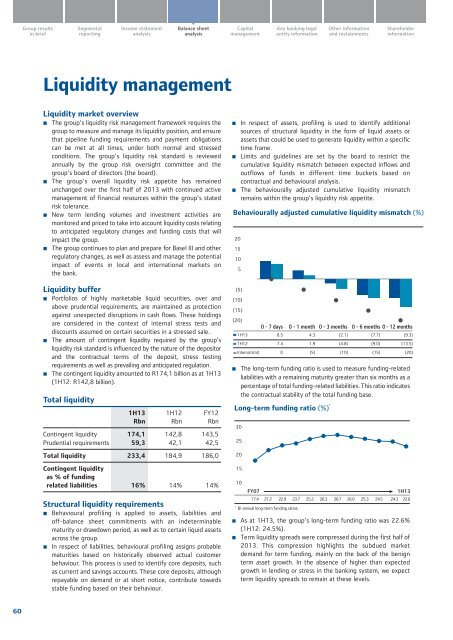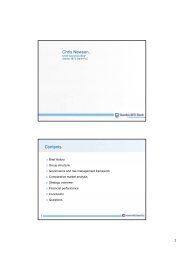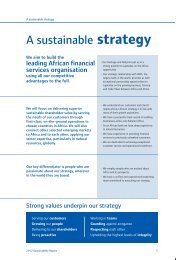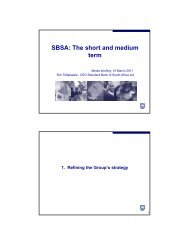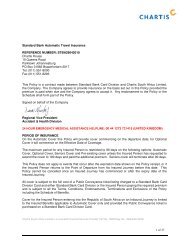Overview of financial results - Standard Bank - Investor Relations
Overview of financial results - Standard Bank - Investor Relations
Overview of financial results - Standard Bank - Investor Relations
Create successful ePaper yourself
Turn your PDF publications into a flip-book with our unique Google optimized e-Paper software.
Group <strong>results</strong><br />
in brief<br />
Segmental<br />
reporting<br />
Income statement<br />
analysis<br />
Balance sheet<br />
analysis<br />
Capital<br />
management<br />
Key banking legal<br />
entity information<br />
Other information<br />
and restatements<br />
Shareholder<br />
information<br />
Liquidity management<br />
Liquidity market overview<br />
• The group’s liquidity risk management framework requires the<br />
group to measure and manage its liquidity position, and ensure<br />
that pipeline funding requirements and payment obligations<br />
can be met at all times, under both normal and stressed<br />
conditions. The group’s liquidity risk standard is reviewed<br />
annually by the group risk oversight committee and the<br />
group’s board <strong>of</strong> directors (the board).<br />
• The group’s overall liquidity risk appetite has remained<br />
unchanged over the first half <strong>of</strong> 2013 with continued active<br />
management <strong>of</strong> <strong>financial</strong> resources within the group’s stated<br />
risk tolerance.<br />
• New term lending volumes and investment activities are<br />
monitored and priced to take into account liquidity costs relating<br />
to anticipated regulatory changes and funding costs that will<br />
impact the group.<br />
• The group continues to plan and prepare for Basel III and other<br />
regulatory changes, as well as assess and manage the potential<br />
impact <strong>of</strong> events in local and international markets on<br />
the bank.<br />
Liquidity buffer<br />
• Portfolios <strong>of</strong> highly marketable liquid securities, over and<br />
above prudential requirements, are maintained as protection<br />
against unexpected disruptions in cash flows. These holdings<br />
are considered in the context <strong>of</strong> internal stress tests and<br />
discounts assumed on certain securities in a stressed sale.<br />
• The amount <strong>of</strong> contingent liquidity required by the group’s<br />
liquidity risk standard is influenced by the nature <strong>of</strong> the depositor<br />
and the contractual terms <strong>of</strong> the deposit, stress testing<br />
requirements as well as prevailing and anticipated regulation.<br />
• The contingent liquidity amounted to R174,1 billion as at 1H13<br />
(1H12: R142,8 billion).<br />
Total liquidity<br />
1H13<br />
Rbn<br />
1H12<br />
Rbn<br />
FY12<br />
Rbn<br />
Contingent liquidity 174,1 142,8 143,5<br />
Prudential requirements 59,3 42,1 42,5<br />
Total liquidity 233,4 184,9 186,0<br />
Contingent liquidity<br />
as % <strong>of</strong> funding<br />
related liabilities 16% 14% 14%<br />
Structural liquidity requirements<br />
• Behavioural pr<strong>of</strong>iling is applied to assets, liabilities and<br />
<strong>of</strong>f-balance sheet commitments with an indeterminable<br />
maturity or drawdown period, as well as to certain liquid assets<br />
across the group.<br />
• In respect <strong>of</strong> liabilities, behavioural pr<strong>of</strong>iling assigns probable<br />
maturities based on historically observed actual customer<br />
behaviour. This process is used to identify core deposits, such<br />
as current and savings accounts. These core deposits, although<br />
repayable on demand or at short notice, contribute towards<br />
stable funding based on their behaviour.<br />
• In respect <strong>of</strong> assets, pr<strong>of</strong>iling is used to identify additional<br />
sources <strong>of</strong> structural liquidity in the form <strong>of</strong> liquid assets or<br />
assets that could be used to generate liquidity within a specific<br />
time frame.<br />
• Limits and guidelines are set by the board to restrict the<br />
cumulative liquidity mismatch between expected inflows and<br />
outflows <strong>of</strong> funds in different time buckets based on<br />
contractual and behavioural analysis.<br />
• The behaviourally adjusted cumulative liquidity mismatch<br />
remains within the group’s liquidity risk appetite.<br />
Behaviourally adjusted cumulative liquidity mismatch (%)<br />
20<br />
15<br />
10<br />
5<br />
(5)<br />
(10)<br />
(15)<br />
(20)<br />
1H13 8.5 4.3 (2.1) (7.7) (9.3)<br />
1H12 7.4 1.9 (4.8) (9.0) (13.5)<br />
Internal limit 0 (5) (10) (15) (20)<br />
• The long-term funding ratio is used to measure funding-related<br />
liabilities with a remaining maturity greater than six months as a<br />
percentage <strong>of</strong> total funding-related liabilities. This ratio indicates<br />
the contractual stability <strong>of</strong> the total funding base.<br />
Long-term funding ratio (%) 1<br />
30<br />
25<br />
20<br />
15<br />
10<br />
FY07<br />
0 - 7 days 0 - 1 month 0 - 3 months 0 - 6 months 0 - 12 months<br />
1H13<br />
17.4 21.2 22.9 23.7 25.2 26.3 26.7 26.0 25.3 24.5 24.3 22.6<br />
1<br />
Bi-annual long-term funding ratios.<br />
• As at 1H13, the group’s long-term funding ratio was 22.6%<br />
(1H12: 24.5%).<br />
• Term liquidity spreads were compressed during the first half <strong>of</strong><br />
2013. This compression highlights the subdued market<br />
demand for term funding, mainly on the back <strong>of</strong> the benign<br />
term asset growth. In the absence <strong>of</strong> higher than expected<br />
growth in lending or stress in the banking system, we expect<br />
term liquidity spreads to remain at these levels.<br />
60


